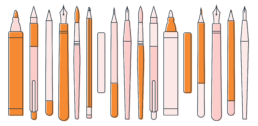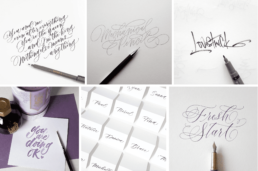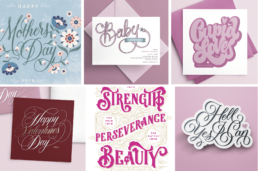
Custom Type: Calligraphy vs. Hand-lettering
November 16, 2021
As these artforms grow in popularity I’m finding a lot of people use the two terms interchangeably when describing their own works, the work of others, or the work they want created for them. But, while calligraphy and hand-lettering can often look very similar, they are not the same! Surprise!
Now how does this help you, right? Knowing the difference between the two can A) make you sound more professional and B) will help you more easily collaborate with designers and creatives in the future. (Plus, it makes me feel better when people use them correctly, just saying.) So read on!
Calligraphy and hand-lettering are both methods used to make letters, words, and phrases look beautiful, interesting, and/or attention-grabbing. They add visual meaning to the words they’re applied to, taking content to the next level and adding to the narrative being expressed. Where they differ is in the approach:
Calligraphy is based on writing letters, words, and phrases, while hand-lettering is based on drawing them.
Before I jump in any further, I want to add a quick side note: calligraphy has an extensive history and cultural backgrounds, but for the purpose of this article I’m going to skip all that for now and focus on the things that are going to be most useful to you as small business owners, bloggers, side hustlers, and overall ambitious ladies. Otherwise, we could be here for days and I know you’ve got a pretty long to-do list.
Okay, back to it!
related article | The non-designer's guide to design jargon
Calligraphy
Calligraphy is really big in the world of stationery and the wedding industry. People will pay thousands of dollars to have a calligrapher address envelopes for their invitations, write out table settings, and create personalized takeaways. You also see it used for creating art prints, very high-end restaurant menus, fancy fonts, and branding. While there are several different styles of calligraphy, arguably the most popular and the ones you’ll see most are script and cursive variations. Tools often used in creating this kind of calligraphy are brush pens, fountain pens, and dip pens (the kind you actually have to dip into the ink) as they allow the calligrapher to change the weight of their lines as they write by simply changing the pressure they apply. Other things I often see used are paintbrushes, chalk, and pencils.
Because I personally don’t practice a lot of calligraphy, I wanted to share examples with you created by a very talented calligrapher and lettering artist I admire: Erica of EP Lettering.

Works by EP Lettering. See more of her work click here!
Hand-lettering
Onto my favorite part: hand-lettering. This method for creating custom type offers a wide array of styles and is great for designing logos, branding, packaging, book covers, posters, and pretty much anything where words are the focal point of a design. With hand-lettering you can make letters look like they’re made of different materials, give words a traditional and old-timey feel, and turn phrases into flourishing and feminine art works. Like calligraphy, hand-lettering also comes in a variety of script styles, some incredibly similar to calligraphy, which is where I think some of the confusion stems from. When it comes to tools, you can use pretty much anything to create hand-lettering! My favorite is just your basic mechanical pencil and tracing paper, but another popular tool you’ve probably seen is chalk.
Both calligraphy and hand-lettering are a really great way to personalize and add interest to type based designs. They quite literally turn words into art.

Works by me!


